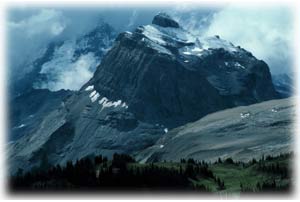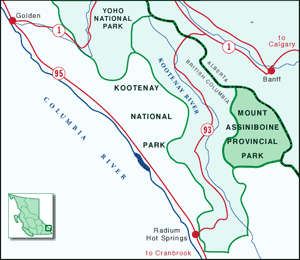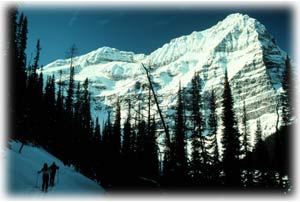|
|
|
|
|
|
|
 Mount Assiniboine Provincial Park's spectacular mountain scenery and wilderness epitomises the best of the British Columbian Rockies. Stunningly ragged peaks, covered in places by glacial ice and year round snow, rise out of flowered alpine meadows that are interspersed with dazzling lakes. Mount Assiniboine itself is a towering peak, remarkably reminiscent of Switzerland's famous Matterhorn. It reaches 3,618 meters (11,800 ft) above sea level. Other peaks in the park that exceed 3,100 meters (10,170 ft) are Mount Magog, Mount Sturdee and the Marshall and Lunnette Peaks. Mount Assiniboine Provincial Park's spectacular mountain scenery and wilderness epitomises the best of the British Columbian Rockies. Stunningly ragged peaks, covered in places by glacial ice and year round snow, rise out of flowered alpine meadows that are interspersed with dazzling lakes. Mount Assiniboine itself is a towering peak, remarkably reminiscent of Switzerland's famous Matterhorn. It reaches 3,618 meters (11,800 ft) above sea level. Other peaks in the park that exceed 3,100 meters (10,170 ft) are Mount Magog, Mount Sturdee and the Marshall and Lunnette Peaks.
The 39,050 hectares (96,000 acres) of wilderness that make up Mount Assiniboine Provincial Park are an integral and beautiful portion of the world renowned Rocky Mountain World Heritage Site. The World Heritage Site links Mount Assiniboine Provincial Park together with Jasper National Park, Banff National Park, Hamber Provincial Park, Kootenay National Park, Mount Robson Provincial Park and Yoho National Park, to create an enormous protected area. The large complex of parks was deemed by the United Nations Educational, Scientific and Cultural Organisation (UNESCO) to be so beautiful and important that in 1990 they declared it a World Heritage Site, in recognition of its global importance.
|

Triangular shaped Mount Assiniboine Provincial Park is located along the BC-Alberta border, within the complex of parks that were together declared by the UN to be Rocky Mountain World Heritage Site. To the west lies Kootenay National Park, while to the east lies Banff National Park. The nearest communities are Golden to west and the Banff townsite, 48 km to the northeast.
The park is entirely unroaded and, consequently, all ground access is on foot. Most people choose to hike into the park from either Kootenay National Park or from Spray Lakes, just south of Canmore, Alberta. For more information on hiking in Mount Assiniboine Provincial Park please read the Recreation section of this page.
As well, helicopter access is possible into Mount Assiniboine Lodge. Visitors interested in this option should check with the Lodge, as the flight access schedules into the park are regulated.

Click on the map to view an enlargement
|

Hiking:
Since there are no roads into Mount Assiniboine it is a wilderness backcountry park. All recreational activities are thus self-propelled and best suited to those with experience in the backcountry. The park is an amazing area for wilderness hiking, camping and climbing. A large number of trails lead throughout the park, from valley bottom to high alpine and everything in between. Hikes range in length from short, easy day hikes to extended treks through rough and rarely travelled terrain. Visitors interested in hiking in the area should check BC Parks' Mount Assiniboine Provincial Park trail information in order to pick a trail that offers them the experience they desire.
Mount Assiniboine and other high peaks in the park have long attracted climbers and mountaineers. However, expertise is required as the peaks are technically challenging, especially given the weaker rock that is associated with much of the area's geology. For information on climbing routes in the park, climbers are advised to contact the local Alpine Club of Canada in Banff, Alberta.
Camping and Accommodation:
Once visitors are in the park, many chose to remain for several days in order to best enjoy its exceptional beauty. There are numerous options for those wishing to camp, with the main campsite located on the east side of Lake Magog. A five-dollar per person fee is charged for this campsite. There is also a group campsite, which can accommodate up to 25 people, located in O'Brien Meadows. A reservation is required for this group camping site.
High quality lodge accommodation is available at the Mount Assiniboine Lodge, in the core of the park. As well, there are five alpine cabin shelters located south of Magog Creek available for rent. These huts, called the Naiset Huts, can be rented through the Assiniboine Lodge for $15 per person per night, or $30 per family. A reservation is recommended for these cabins, also available through the Assiniboine Lodge for a further $5 charge. It is possible to stay in the cabins without a reservation, but those hoping to do so should be prepared to camp, in case they are full.
A climbing shelter, the R.C. Hind Hut, is located in Assiniboine Bowl and is primarily used as a base camp for mountain climbers ascending Mount Assiniboine. It sleeps 16 and a reservation must be made before staying in it, through the Assiniboine Lodge. The charge for the Rind Hut is $15 per night, plus a $5 reservation fee. Cabins are also found at Surprise Creek, Mitchell River and in the Police Meadows.
For information on reservations, or to make a reservation, please contact Mount Assiniboine Lodge, Sepp and Barb Renner, Box 8128, Canmore, Alberta, T1W 2T8, Phone: (403) 678-2883, Fax: (403) 678-4877 or E-mail: assinilo@telusplanet.net.
 Winter Recreation: Winter Recreation:
Being high in the Canadian Rocky Mountains, Mount Assiniboine Provincial Park is well known for its abundance of snow, and some prefer to visit the park while it is under this sparkling white blanket. Ski touring is no doubt one of the most magical ways to travel through Mount Assiniboine's awe-inspiring scenery. It is also a challenging way to visit, and those who chose to do so should be experience, well equipped and extremely knowledgeable regarding avalanche safety.
The Naiset Huts are available for winter accommodation, but a reservation must be made during the winter months. Please contact the Assiniboine Lodge for reservation information. There are a variety of ski touring routes available to visitors, including the most popular, through Assiniboine Pass. Other routes lead from the Sunshine Ski Area in Banff or through the Valley of the Rocks. For more detailed information on these trails, please click here.
|

Mount Assiniboine Provincial Park is an ecologically important area because it protects such a wide variety of uninterrupted habitats, from forested valley bottoms to rugged and icy peaks. At lower elevations conifer forests dominate, composed mainly of spruce, with some stands of alpine fir and lodgepole pine. Some open areas are found at lower elevations as well, and these are home to false azaleas, several types of berries, white rhododendrons and a few red elders.
At slightly higher altitudes (2,100-2,400m or 6,900-7900 ft) the sub-alpine begins. Here, a more open forest of alpine larch becomes intertwined with alpine fir and Engelmann spruce, with heather and grouseberries forming the forest floor. Short, scrubby willows and bog birch are common in wetter areas and along streams.
At the highest elevations the alpine becomes the dominant ecosystem, characterized by rock formations covered with low lying plants such as stonecrop, white flowering avens, moss campion, cinquefoil, arctic willows and several species of saxifrage. In addition, Mount Assiniboine Provincial Park is endowed with beautiful and abundant alpine flower meadows, filled with western anemones, alpine arnica, columbine, Indian paintbrush, spring beauty, alpine fleabane, mountain daisies, and hundreds more wildflower species. The peak blooming period is short in this harsh high-altitude, mountain environment, and is typically during the midsummer.
As a result of the richness and variety of habitats found in Mount Assiniboine Provincial Park many animals are able to thrive in the area. Grizzly and black bears, mountain goats, bighorn sheep, moose, elk and mule deer are all abundant, as are harder to see species such as wolves, coyotes, wolverines, badgers and martens. In the high alpine, and approaching the craggy peak of Mount Assiniboine, pikas, hoary marmots and mantled ground squirrels are the dominant species.
Birds are also very common in Mount Assiniboine Park, with ninety-three species having been sighted. The most commonly spotted of these many species are northern harriers, grey jays, Clark's nutcrackers, white-tailed ptarmigans, pine grosbeaks, rosy finches, pine siskins, boreal chickadees, chipping sparrows and white-crowned sparrows.
|

The Mount Assiniboine area, with its abundance of wildlife and plant resources, has a long history of indigenous use. The people of the Ktunaxa First Nation were among the earliest to make their home in the area, with a presence in the region dating back thousands of years. Historically, Shuswap, Pelgan and Blood people also visited the area from time to time.
Fairly recently, the region was discovered by prairie First Nations, including the Assiniboines, who added it to their hunting grounds. When, in 1880, geologist G.M. Dawson first visited the area he named its distinctive peak after these people, not knowing that it was in fact the traditional homeland of the Ktunaxa.
In the early 19th century, as Europeans began to become acquainted with western North America, word began to spread of the newly established Canadian National Parks in the wild and beautiful Rocky Mountains. As more and more Europeans visited the national parks, the British Columbia Provincial Government began to display interest in protecting some of the area as well.
At the same time, due to climbing interest in the area, the British Columbia chapter of the Alpine Club of Canada was pushing hard for the stunning Mount Assiniboine area to be preserved for recreation. A grouping of European mountaineers, particularly from Switzerland, had begun to visit the central Rockies area at the turn of the century, many of its peaks for the first time.
Especially intriguing to the Swiss climbers was Matterhorn-like Assiniboine peak, which was very visible from the Sunshine Meadows region of Banff. As a result of the mountaineering attention it attracted, the Assiniboine area became increasingly well known, and was soon an obvious candidate for protection.
On February 6, 1922 the British Columbia government set aside 5,120 hectares (12,600 acres) as Mount Assiniboine Provincial Park, only the seventh provincial park to be created in BC. In 1973, in recognition of the importance of the lands surrounding the park, Mount Assiniboine Provincial Park was expanded to seven times its previous size. Today, at 39,050 hectares (96,000 acres), the park remains as wild and beautiful as ever, a living museum to pass onto future generations.
"Especially intriguing to the Swiss climbers was Matterhorn-like Assiniboine peak, which was very visible from the Sunshine Meadows region of Banff."
|
|
Return to the Kootenay Rockies Region
Become Involved!

|
|

